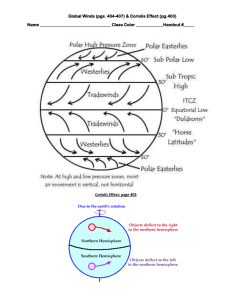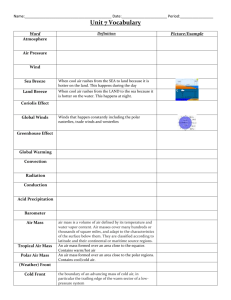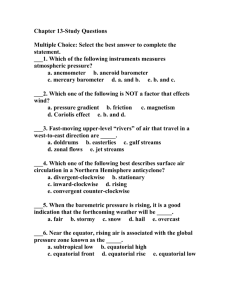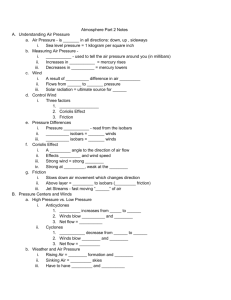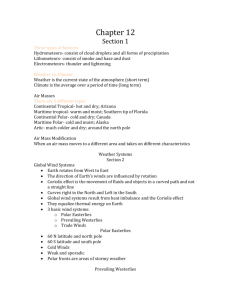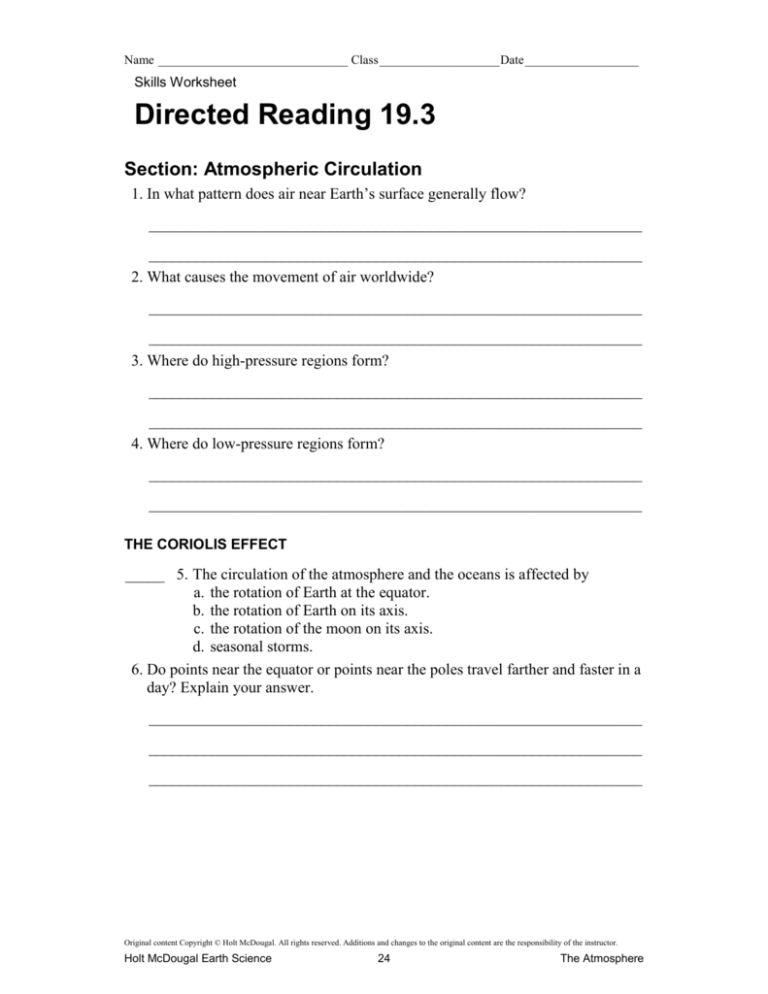
Name ______________________________ Class ___________________ Date __________________
Skills Worksheet
Directed Reading 19.3
Section: Atmospheric Circulation
1. In what pattern does air near Earth’s surface generally flow?
_______________________________________________________________
_______________________________________________________________
2. What causes the movement of air worldwide?
_______________________________________________________________
_______________________________________________________________
3. Where do high-pressure regions form?
_______________________________________________________________
_______________________________________________________________
4. Where do low-pressure regions form?
_______________________________________________________________
_______________________________________________________________
THE CORIOLIS EFFECT
_____ 5. The circulation of the atmosphere and the oceans is affected by
a. the rotation of Earth at the equator.
b. the rotation of Earth on its axis.
c. the rotation of the moon on its axis.
d. seasonal storms.
6. Do points near the equator or points near the poles travel farther and faster in a
day? Explain your answer.
_______________________________________________________________
_______________________________________________________________
_______________________________________________________________
Original content Copyright © Holt McDougal. All rights reserved. Additions and changes to the original content are the responsibility of the instructor.
Holt McDougal Earth Science
24
The Atmosphere
Name ______________________________ Class ___________________ Date __________________
Directed Reading continued
7. Why does air follow a curved path?
_______________________________________________________________
_______________________________________________________________
_______________________________________________________________
8. The curving of the path of a moving object from an otherwise straight path due
to Earth’s rotation is called the __________________________.
9. What determines the path along which the Coriolis effect deflects moving
objects?
_______________________________________________________________
_______________________________________________________________
_______________________________________________________________
10. In which direction does the Coriolis effect deflect moving objects in the
Northern Hemisphere? in the Southern Hemisphere?
_______________________________________________________________
_______________________________________________________________
_______________________________________________________________
11. How does the speed of an object relate to the Coriolis effect?
_______________________________________________________________
_______________________________________________________________
_______________________________________________________________
12. How do the mass and travel distances of air and ocean currents relate to the
Coriolis effect?
_______________________________________________________________
_______________________________________________________________
13. In general, on which types of objects is the Coriolis effect detectable?
_______________________________________________________________
_______________________________________________________________
Original content Copyright © Holt McDougal. All rights reserved. Additions and changes to the original content are the responsibility of the instructor.
Holt McDougal Earth Science
25
The Atmosphere
Name ______________________________ Class ___________________ Date __________________
Directed Reading continued
GLOBAL WINDS
_____ 14. What are the three looping patterns of air flow in each hemisphere
called?
a. wind belts
b. convection cells
c. prevailing winds
d. global air flow
_____ 15. A wind belt is characterized by prevailing winds that
a. flow in one main direction.
b. flow from the southwest.
c. flow from the northeast.
d. flow in all directions.
_____ 16. The prevailing winds that blow from east to west from 30° latitude to
the equator in both hemispheres are called the
a. trade winds.
b. polar easterlies.
c. wind belts.
d. westerlies.
_____ 17. In the Northern Hemisphere, trade winds flow from the
a. southeast.
b. south.
c. northeast.
d. northwest.
_____ 18. From what direction do trade winds flow in the Southern Hemisphere?
a. the northeast
b. the southeast
c. the north
d. the southwest
_____ 19. The prevailing winds that blow from west to east through the
contiguous United States are the
a. trade winds.
b. doldrums.
c. polar easterlies.
d. westerlies.
Original content Copyright © Holt McDougal. All rights reserved. Additions and changes to the original content are the responsibility of the instructor.
Holt McDougal Earth Science
26
The Atmosphere
Name ______________________________ Class ___________________ Date __________________
Directed Reading continued
_____ 20. What are the prevailing winds that blow from east to west between 60°
and 90° in both hemispheres?
a. the westerlies
b. the polar easterlies
c. wind belts
d. the trade winds
_____ 21. A stormy region created where the polar easterlies meet warm air from
the westerlies is called a
a. trade wind.
b. doldrum.
c. front.
d. wind belt.
_____ 22. The sun’s rays shift northward and southward during the changing
seasons of the year causing a shift in the position of
a. convection zones and horse latitudes.
b. fronts and trade winds.
c. pressure belts and wind belts.
d. convection zones and pressure belts.
In the space provided, write the letter of the description that best matches the term
or phrase.
_____ 23. doldrums
_____ 24. horse latitudes
_____ 25. jet streams
_____ 26. subtropical jet streams
_____ 27. polar jet streams
a. narrow bands of winds formed when
very warm equatorial air meets the
cooler air of the middle latitudes
b. narrow bands of strong winds that
blow in the upper troposphere
c. bands of winds formed as a result of
density differences between cold
polar air and the warmer air of the
middle latitudes
d. subtropical high-pressure zones with
weak and variable winds
e. a narrow zone at the equator where
the trade wind systems meet
Original content Copyright © Holt McDougal. All rights reserved. Additions and changes to the original content are the responsibility of the instructor.
Holt McDougal Earth Science
27
The Atmosphere
Name ______________________________ Class ___________________ Date __________________
Directed Reading continued
LOCAL WINDS
Use the terms from the list below to complete the sentences that follow. Each term
may be used only once.
valley breeze
land breeze
breezes
mountain breeze
sea breeze
local winds
28. Air movement influenced by local conditions and local temperature variations
often cause ______________________, which are not part of the global wind
belts.
29. Winds that blow at speeds of less than 50 km/h are called
______________________.
30. As warm air above land rises and the cool air above water moves in to replace
it, a cool wind moving from water to land, called a
______________________, forms in the afternoon.
31. Overnight, the land offshore cools more rapidly than the water does, and a sea
breeze is replaced by a ______________________, which flows from the cool
land toward the warmer water.
32. During the day in mountainous regions, a gentle breeze called a
______________________ forms when warm air from the valleys moves
upslope.
33. At night in the mountains, cool air descends from the peaks to the valleys,
creating a ______________________.
Original content Copyright © Holt McDougal. All rights reserved. Additions and changes to the original content are the responsibility of the instructor.
Holt McDougal Earth Science
28
The Atmosphere


